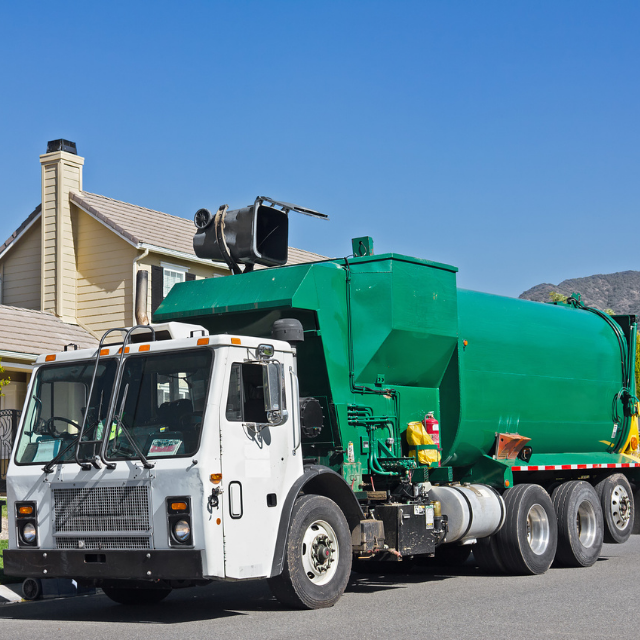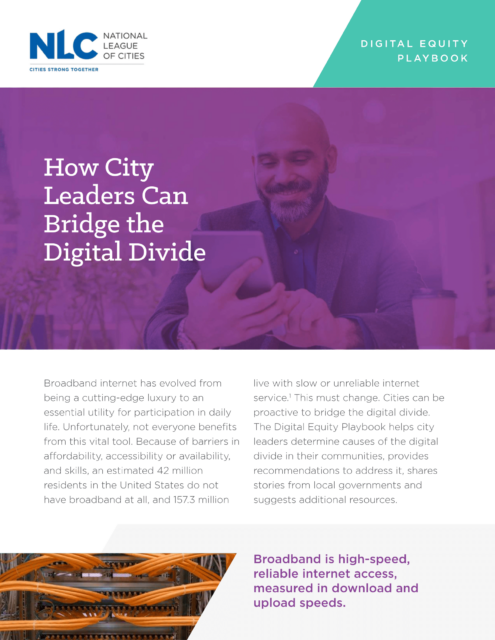
The first step in addressing the digital divide is understanding what causes it. A broadband needs assessment enables city leaders to explore the extent of the digital divide, who is being excluded, what broadband service is currently available and the solutions that cities could bring to the table.
A broadband needs assessment is a four-part process:
- Connect with the community
- Evaluate the digital equity landscape
- Gather foundational data
- Report on findings
Data provided by mySidewalk
Connect with the community
The community is a city’s greatest resource in determining how to address the digital divide. Community members have experience in what it takes to use the internet in their city. They know the challenges and should actively participate in exploring and determining solutions. They can provide insight into gaps in internet service, barriers to affordable service and devices, and training to improve internet skills. Community members can be residents but should also include students, educators, librarians, business owners and workers so that the city gets a clear picture of the digital divide.
Find the digital equity leaders
Community members understand the importance of broadband. Some may already be involved in or leading efforts to address this problem. Find those digital equity leaders, learn about what they are doing and determine how to best collaborate. Community leaders who are not already involved in this work can easily become digital equity leaders. They hold high levels of social capital, can encourage increased engagement across the community and can amplify digital inclusion efforts, as this work overlaps with other, nondigital inclusion-focused social justice efforts. In this way, these leaders can advance the idea of digital inclusion within the framework of larger social change.
Proactively engage and include residents most adversely affected by the digital divide. Actively include communities historically marginalized by the digital divide in every stage of a digital inclusion initiative (planning, implementation and evaluation). Elevate these community voices in the decision-making process. This ensures that a city builds with, not just for, a community.
Form a broadband working group
Establishing a working group of community members and partners interested in sharing their experiences and perspectives on digital equity solutions is an effective way to sustain this work. This group could be part of the city’s formal boards and commission structure, which includes public meetings and defined agendas. However, given city organizational structure, the group could also be an ad hoc task force, advisory board or something similar, so that the process of establishing an official group does not prevent stakeholders from bringing these voices to the table. Providing stipends to participants can ensure a wider range of participants. This work takes time and effort. Forming a broadband working group will ensure that solutions meet community needs. To establish a broadband working group or commission with a clearly defined purpose and participant roles and responsibilities, a digital equity working group charter can be helpful.

Putting into Action
Detroit, MI
Detroit’s Connect 313 initiative, a data-driven, community-based digital inclusion effort, elevates community input. The organizational hierarchy of the Connect 313 initiative demonstrates the importance of community input at every level.16
The initiative’s Community Advisory Council sits at the same level as its board. This means that every committee within Connect 313 reports to the Community Advisory Council. Accordingly, Detroit residents can ensure that every proposal is consistent with community values and that the residents’ thoughts drive the executive leaders’ conversation.
Establish multiple points of engagement with the community
There is no one-size-fits-all solution to the digital divide. It is a constantly evolving problem that city leaders must comprehend deeply in order to address. Consistent engagement with the community to understand how the problem changes is a necessary component of this work. Consider a community engagement roadmap to establish a plan for updating knowledge of the digital divide. The community’s voice should be present at all steps of the exploration process.
Engage community members where they are
Rather than expecting community members to find a city-run effort to address the digital divide, meet them where they live and work. Community pop-ups in various neighborhoods or community workshops in trusted spaces such as churches, libraries and schools can achieve this. Ensure a mix of digital and in-person engagement. Many of the voices that cities need to hear are digitally divided, so do not expect high levels of response to digital-only outreach efforts, such as emails, posts on the city website or online-only surveys.
Reduce barriers to participation
Many community members most affected by the digital divide do not have time to attend regular meetings. Actively try to reduce participation barriers and respect participants’ time by offering amenities such as childcare services, transportation money, food and drink, and gift cards.
Ensure that language translation services are available. Different reasons for the digital divide likely exist for different racial and ethnic groups in the community. These nuances could be key to addressing concerns about digital disconnection. Translation services can help reveal these details.

Putting into Action
Long Beach, CA
Long Beach, CA, actively addresses power dynamics in community engagement. To maximize collective impact, Long Beach assembled a 50-person multidisciplinary Digital Inclusion Stakeholder Committee to provide overall vision, strategic guidance and oversight in the development of the city’s digital inclusion roadmap.17 The committee comprised cross-sector partners, including community members, community-based organizations, housing authorities, workforce development organizations, schools, libraries and internet service providers. To directly mitigate power dynamics, the committee hired a neutral moderator, set up the meeting room in a collaborative format (e.g., rectangle boardroom setup rather than presentation mode), had an on-site translator, offered childcare services, and provided food, beverages and gift cards to participants.
Ensure representative data
To be useful, a broadband needs assessment must be statistically valid and represent the community at large. Ensuring that the broadband needs assessment represents all communities can highlight racial disparities in internet and device access. Therefore, any outreach, surveying or focus group discussions must penetrate difficult-to-reach communities and be sufficiently large. Successful surveys must include in-person canvassing, large outreach events coordinated with community partners and multilingual campaigns.
If outreach efforts include asking for demographic information, be sure to collect only information that will be used. Some residents may hesitate to share their information, so ask only for what is needed. Be clear about the purpose of collecting this information and how it will be aggregated or anonymized.
Ensure racial equity in digital equity efforts
Racial equity refers to an outcome in which racial identity does not predict life outcomes.18 In contrast, racial equality involves treating all races the same. Although an important principle, racial equality does not help close the gap if people start from unequal places. For this reason, racial equity avoids a one-size-fits-all approach and, instead, tailors policies and programs, and prioritizes communities historically and consistently excluded from access to resources. Because the digital divide particularly affects BIPOC communities, it is important to ensure that digital equity efforts investigate these differences and proactively address the digital divide in these communities.
Conduct a root cause analysis
A root cause analysis enables deeper exploration of an issue. A root cause analysis seeks to highlight key elements of systemic racism, including history, culture, interconnected institutions and policies, and racial ideologies. Identifying root causes and contributing factors to the digital divide can reveal possible strategies and solutions to deeper problems. For instance, affordability is a major barrier to internet access. However, lack of funds for internet service or devices is not the whole story. The affordability issue ultimately stems from larger root causes, such as workforce development, low minimum wages and high housing costs. Too often, people think of digital inequality as a technological problem. However, at its core, much of digital inequality stems from hundreds of years of racial injustice.19 Consider completing a root cause analysis to further investigate the digital divide.
Avoid tokenization of diverse voices
A person from a marginalized community does not speak for their entire community, nor should they carry the responsibility of speaking on behalf of their race or ethnicity. That is why cities should engage underserved communities through multiple venues, to increase the overall diversity of voices and lived experiences. Check out the Government Alliance on Race & Equity (GARE) communications guide for more information on how to communicate about racial equity and encourage participation from underrepresented parts of the community.20
Consider how different populations use the internet differently
It would be wrong to assume that BIPOC communities fear or do not understand the internet just because they do not use it in the same manner as White Americans do.21 Instead, efforts to create digital equity must acknowledge that different populations engage online in different ways. For instance, Black Americans were initially much more likely to use Twitter than White Americans were. Black Americans still use Twitter at higher rates and more frequently than their White neighbors do.22 “Black Twitter,” a phrase used to describe Twitter’s strong Black virtual community, has been recognized as key to Black activism and gave rise to the #BlackLivesMatter movement. Similarly, Latinx Americans rely on WhatsApp for community and advocacy at much higher rates than White or Black Americans do.23 For many communities, Twitter or WhatsApp are not just social media platforms but tools for advocacy, grassroots organization, dialogue and dissemination of critical information.24
Ensure race-conscious strategies and solutions
In developing a digital equity strategy, think about how the city can target BIPOC communities directly. This could take the form of infrastructure investments in low-income BIPOC communities or direct funding to and partnerships with historically Black colleges and universities and minority-serving institutions. Dialogues with community organizations, community leaders and residents can help stakeholders tailor strategies for city neighborhoods that have digitally disconnected residents. These community conversations can be particularly effective when trusted partners and community leaders host them. Inclusion of all stakeholder voices in the conversation is key.
Acknowledge that digital equity efforts alone cannot solve racial inequity
Access to affordable internet and devices will not solve entrenched consequences of racial inequality, such as financial exclusion, redlining and residential segregation, and inadequate access to health care. Instead, digital equity represents a small part of a larger conversation in which communities must engage regarding systemic inequalities. Digital equity is a step in the long road to addressing racial inequity more holistically.

Putting into Action
Philadelphia, PA
The City of Philadelphia, PA, which has a Black population of 42 percent, is applying a racial equity lens to its digital equity efforts. A 2018 report found that more than 27 percent of the city’s households lacked high-speed internet, and that proportion reached 68 percent in some neighborhoods.25 The city’s goal is to provide affordable, simple and reliable digital solutions for all Philadelphians. City leaders are focusing on three core strategies that will prioritize BIPOC residents and high-poverty neighborhoods:
- Ensuring all K-12 public students have internet access.
- Reimagining the future of public computing centers.
- Guaranteeing that all residents have access to affordable, reliable digital solutions.26
Evaluate the digital equity landscape
No matter where a city is in its digital equity journey, stakeholders should learn from previous digital equity efforts, to inform current work. Whether the city or community led this work, it is important to know who was involved, what happened, why it worked (or did not work) and how it has affected the current causes of the digital divide. Search for these answers within and outside of the organization. Connect with community members to learn more. Look to state and federal partners to understand how the city has worked with them.
Understand the community’s digital history
To avoid repeating mistakes, city leaders should determine what their communities have done in the past to address the digital divide. For instance, has the community conducted prior feasibility studies? Have there been previous connectivity projects that did not have the intended outcome? Did prior connectivity projects address affordability? Did the community pursue public-private partnerships in the past? Did the community receive funding from a state initiative or from the federal government? Talk with community partners, or connect with the state broadband office, to learn what has already been done. Understanding the community’s digital history will more quickly move the conversation to solutions.
Assess the regulatory environment
The community’s regulatory environment can significantly impact the digital divide. An important question for local digital equity efforts is whether the city has the legal authority to take actions such as building publicly owned broadband infrastructure. Some state laws or constitutions may grant this power; others may prohibit such efforts. Case law can also significantly affect the application of local provisions.27 When assessing the community’s regulatory environment, consider the following questions:
- Is the city in a Dillon Rule state, which limits local autonomy, or a Home Rule state, which grants broader local authority?
- Are there state laws, local charters, ordinances, franchises or other agreements that preempt or severely restrict the city’s involvement in telecommunications? If so, to what degree is the city preempted or restricted?
- Would an internet service provider be able to access and leverage existing infrastructure, such as utility poles or conduit?
- Is there an efficient, predictable permit and construction process?
Knowing how regulation may affect the city’s ability to provide specific digital equity solutions will help narrow the responses and proposed solutions to those that can be most effective in the short, near and long terms.
Do not assume that preemption prohibits all actions
Varying degrees of preemption exist that could affect the city’s ability to address the digital divide. Express preemption occurs when state law explicitly limits lower levels of authority. Implied preemption occurs when a court or attorney-general opinion interprets non-explicit language in a way that creates a conflict between state and local law. This includes general state barriers to local policy, which could discourage municipal broadband efforts. Depending on the type of preemption and the language of legislation or case law, the city may have flexibility regarding its options to bridge the digital divide.
Consider how other communities in the state are navigating the regulatory environment
Many cities have taken the lead in exploring the limits of their state’s regulatory environment. Connect with other cities to learn more about their experiences navigating preemption and the legal landscape to determine how they have expanded their communities’ access to broadband.
Gather foundational data
Publicly available data exists to help stakeholders assess the digital divide in the community. To know the extent of the problem, it is necessary to collect additional information to close gaps or confirm publicly available data. Some cities use surveys to gather information on current internet service, actual internet speeds and pricing information. Some state broadband offices have already undertaken this work. It may be useful to connect with them to understand their results and outreach methods. Data from the American Community Survey can help city leaders better understand things such as home computer ownership. However, no locally available data sets on digital literacy exist. Consider a digital divide survey to gather this foundational information in the community.
Digital literacy is the ability to use information and communication technologies to find, evaluate, create and communicate information, which require both cognitive and technical skills.28

Putting into Action
San Antonio, TX
San Antonio’s digital inclusion survey and assessment provides a model for other communities. Because of the comprehensive outreach efforts, more than 6,048 San Antonians responded to the survey, with an average of 500 responses per council district. The survey found that there is a 30 percent difference in access to the internet between the best and worst connected council districts. Access to a computer also varied among council districts, from 96 percent to 75 percent. The final report includes detailed information on the city’s research methodologies, community engagement efforts, connectivity report cards for each city district, and the surveys and community materials used in the campaign.29 This information may be helpful to other cities looking to more fully explore the digital divide in their communities.
Conduct mapping of internet service provision
National data on broadband availability, compiled using the FCC’s Form 477 data, is notoriously inadequate.30 Form 477 inaccurately reflects cities’ access to internet service because it relies on internet service providers’ self-reporting and includes advertised rather than actual speeds. In addition, for fixed broadband service, the FCC considers an entire census block served even if just one home within that block has or could have internet access. Although the Broadband DATA Act (included in the Consolidated Appropriations Act of 2021) directed the FCC to improve the accuracy and usefulness of its broadband maps, the process will likely take years. For mobile broadband service, the FCC has begun to require providers to submit standardized coverage maps so that mobile broadband data can be compared across providers, but this effort has just begun.31Gathering this information from community members is the best way to obtain the detail stakeholders need to bridge gaps in availability.

Putting into Action
Shreveport, LA
City leaders in Shreveport, LA, use garbage trucks to visualize the digital divide. Shreveport’s technology team created an affordable Wi-Fi sensor program by attaching inexpensive Raspberry Pi hardware and GPS chips to garbage trucks. While the garbage trucks complete their routes, the sensor detects Wi-Fi networks so it can provide a more comprehensive picture of how many households pay for internet access and their locations. The sensor data helped the city obtain a $200,000 grant from the local power company to invest in Wi-Fi infrastructure.32 Cities without in-house technical expertise could partner with a university or local training program for support with a mapping project.
Measure actual internet speeds
Identifying high-quality internet requires knowing the speed and latency of the internet service. Speed, or bandwidth, reflects a measurement of how much data can be moved from one point to another in a certain amount of time (e.g., megabits per second). Latency is how long it takes for data to travel from one point to another. The FCC’s official definition of broadband is a minimum download speed of 25 Mbps and upload speed of 3 Mbps. There has been a recent push by community advocates and local governments for federal broadband speed standards to raise to 100 Mbps symmetrical (same speed for download and upload).
Significant differences can exist between the speeds that internet service providers advertise and the actual speeds customers receive. Measuring actual internet speeds will better determine the community’s areas of need.
Internet speed testing should incorporate the following questions:
- Are the offered speeds uniform throughout the network?
- How do upload speeds compare to download speeds?
- How do actual speeds differ from advertised speeds?
- How do the internet speeds available in this community compare to those in similar communities?
- Is service — particularly upload availability — sufficient for telework, telehealth services and online education?

Putting into Action
New York City, NY
New York City, NY, used federal data for its broadband needs assessment. The NYC Internet Master Plan relied on federal data from the American Community Survey (ACS) and the FCC’s Form 477 data to assess which households had internet service available and the level of competition in each neighborhood. City officials also looked at the adoption of those services in neighborhoods across NYC. Although this data might not be as granular as crowdsourced data, it offers a strong starting point for a city to assess gaps in service.33
Reliability is a key component of high-quality internet. Although there is no measure for it, as there is for speed, it is just as important for internet service to be consistently available to users and operate as expected.
Helpful Resource
- In summer 2021, Consumer Reports launched a new project, Let’s Broadband Together, to identify how much people pay for their internet plans and the level of service they receive. Survey participants complete an internet speed test, upload their bill and provide demographic information. These findings will help Consumer Reports and its partners to advocate for better, more affordable internet for all.34
Collect internet service pricing information
Internet service providers have a wide range of plans and options for customers to consider. This information is rarely publicly available. Obtaining this information from residents, businesses and community anchor institutions, such as schools and libraries, will help identify affordability issues and highlight opportunities to address them.
Internet service pricing assessments should consider the following questions:
- Can residents, businesses and community anchor institutions afford the services offered?
- What is the actual price of the service after promotional pricing expires?
- Are there discounted subscriptions for low-income residents?
- How difficult is it to apply for these subscriptions? What eligibility requirements exist? How frequently do subscribers become ineligible?
Map current public and private assets
To better understand potential solutions to the digital divide, it is vital to identify assets in the community and their locations so that stakeholders can more easily build on existing efforts.
Mapping current assets should incorporate the following questions:
- Which public or private assets could stakeholders use to bridge the digital divide?
- Are there unused infrastructure assets, such as dark fiber, conduit, towers or rooftops, that stakeholders could deploy to expand internet access?
- Are there public computer centers whose programs could include building digital skills?
- Are there community centers where residents and digital navigators could meet to diagnose and address barriers to broadband adoption?

Putting into Action
Boston, MA
Boston, MA, has been exploring unused resources to lay the foundation for more widespread internet access in the community. Through its needs assessment process, Boston discovered shadow conduit, or an unused system of underground pipes through which fiber optic cable can run, that it could use to expand its fiber network. The city published this information on an interactive map that displays city-owned shadow conduit.35
Start with existing data sources about the community
Although the quality of publicly available data sources varies, start with American Community Survey (ACS) and FCC data to define the extent of the digital divide in the community. Before thoroughly examining additional data sources or starting new data collection, determine whether the ACS and FCC data matches what the community has reported about the digital divide. Much of this publicly available data is at the county or census tract level, which does not always align with city boundaries. The NLC broadband needs assessment maps this data to city boundaries so that the information is actionable from cities.
Value qualitative and quantitative data
Quantitative data is an important indicator of connectivity. It is important for cities to disaggregate data by race and ethnicity, income level, gender, age, geographic areas and other relevant indicators. However, in addition to incorporating quantitative data, a comprehensive broadband needs assessment should also include qualitative data by prioritizing residents’ lived experiences. Cities can integrate lived experiences by conducting community interviews and engaging in storytelling workshops.
Partner with local universities, research centers and library systems
Local universities and research centers often have the tools and skills, such as geographic information systems expertise and data analysis skills, to help stakeholders complete mapping efforts. They can provide volunteers to carry out well-crafted surveying tasks. Universities and research centers may also be able to tap into additional funding sources for cities’ exploration of the digital divide in the community.

Putting into Action
Chicago, IL
The University of Chicago received $1.2 million from data.org to map Chicago’s digital divide. The project’s research team will collect new, detailed data on internet access and performance in thousands of Chicago households, explore internet service infrastructure to those neighborhoods and assess human factors such as affordability, digital skills and how community members use the internet.36
Coordinate with the state broadband program
All 50 states have established a broadband office, task force, commission or authority. An increasing number of state broadband programs maintain their own broadband maps, which can serve as a valuable starting point for local communities launching their own mapping initiatives. These offices may be willing to share granular data on internet service, speeds and costs. BroadbandUSA has information about how to connect with state broadband programs.37
Separately assess residential, business and community anchor institutions’ broadband
Residents, local businesses and community anchor institutions all have different needs for broadband and devices. Therefore, it is important to consider each segment of the community independently. In addition, the COVID-19 pandemic drastically increased work-from-home demands in some communities, which may affect the future network needs of cities’ residential areas.
Helpful Resources
- Assess Internet Speeds with SpeedUpYour City – A crowd sourcing citizen speed test tool to help community leaders understand the current state of connectivity.
- Gather Internet Connectivity Data with Measurement Lab (M-Lab) – An open-source project that provides data on internet connectivity to help policymakers understand internet performance over time.
Report on findings
After connecting with the community, evaluating the digital equity landscape and gathering foundational data, city officials need to report those findings before determining and implementing solutions.
Communicate findings far and wide
To build momentum toward solutions and implementation, city officials should widely communicate the results of the broadband needs assessment. This will convey the importance of prioritizing this work and demonstrate readiness to the community and potential partners. Share findings with community members, particularly those who gave input through surveys, focus groups or other engagement methods. Executive leaders should know the highlights of these findings, to ensure they can advocate for necessary funding and support when the time comes.
Regularly update broadband needs assessment
Consider the needs assessment as a living document. As the community’s broadband needs shift, this foundational information should be updated so that current efforts reflect the change. Too many reports sit on the shelf after stakeholders look at them once. To truly make an impact in bridging the digital divide, ensure that this information is up to date. The ACS five-year report includes new data on computer and internet use. Cities should refresh the broadband needs assessment on that basis, at a minimum.
Think beyond formal reports
Because the information from the broadband needs assessment constantly evolves, consider displaying and sharing that information in a more dynamic format than a report. Consider creating an infographic or building a dashboard to convey this information to various audiences.
Highlight findings whenever possible
Get the community talking about the state of the digital divide. Use the findings of the broadband needs assessment to build support for this work, and drive home the importance of access to high-quality, reliable internet for residents’ lives.
Get the Getting Started with Digital Equity: Broadband Needs Assessment summary for the Digital Equity Playbook.
Learn how you can bridge the digital divide in your city.

